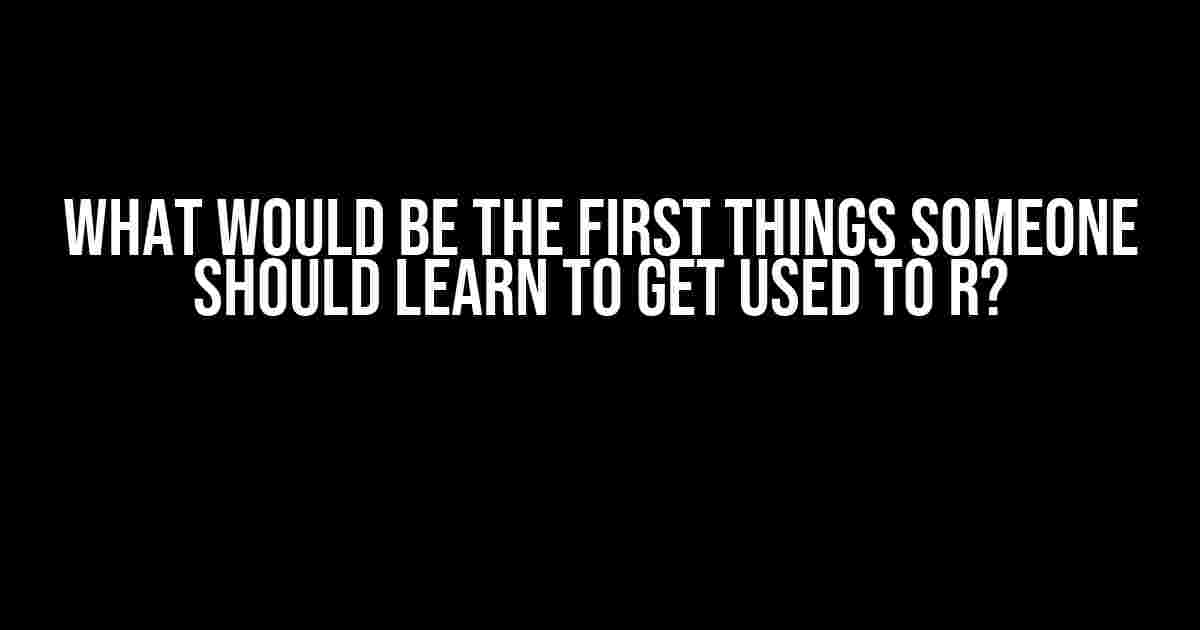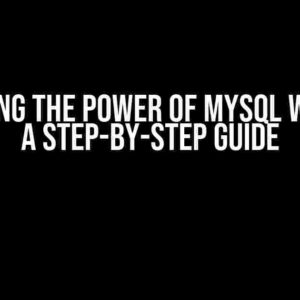R, the programming language and environment for statistical computing and graphics, can be intimidating for beginners. With its unique syntax and plethora of libraries, it’s natural to feel overwhelmed. But fear not, dear reader, for we’re about to embark on a journey to demystify the world of R and get you started with the basics!
Step 1: Get Familiar with the R Environment
Before diving into the world of R, it’s essential to get comfortable with the R environment. Here are a few tips to get you started:
- Download and install R from the official R Project website.
- Familiarize yourself with the R console, where you’ll write and execute your code.
- Learn basic R commands, such as `>`, `?`, and `args()`, to navigate the console.
Step 2: Understand R Basics
R has its own syntax and rules, and it’s crucial to understand the basics before moving forward. Here are the essential concepts to grasp:
- Variables and Data Types: Learn about the different data types in R, such as numeric, character, logical, and more. Understand how to assign values to variables using the `<-` operator.
- Vectors: Discover how to create and manipulate vectors in R, including indexing, concatenation, and basic arithmetic operations.
- Functions: Learn about built-in R functions, such as `sum()`, `mean()`, and `plot()`, and how to create your own custom functions.
# Assign a value to a variable
x <- 5
# Create a vector
y <- c(1, 2, 3, 4, 5)
# Use a built-in function
result <- sum(y)
# Create a custom function
add_numbers <- function(a, b) {
a + b
}
result <- add_numbers(2, 3)
print(result) # Output: 5
Step 3: Data Manipulation and Visualization
Data manipulation and visualization are essential skills in R. Here are the key concepts to master:
Data Frames: Learn how to create, manipulate, and merge data frames, which are two-dimensional tables of data.
Data Manipulation: Understand how to filter, sort, and group data using dplyr and other popular R libraries.
Data Visualization: Discover how to create informative and engaging visualizations using ggplot2, base plots, and other popular visualization libraries.
# Create a data frame
df <- data.frame(Name = c("John", "Mary", "Jane"), Age = c(25, 31, 22))
# Filter a data frame
filtered_df <- df %>%
filter(Age > 25)
# Create a ggplot2 visualization
library(ggplot2)
ggplot(df, aes(x = Age)) +
geom_histogram(binwidth = 5) +
labs(x = "Age", y = "Frequency")
Step 4: Install and Load Libraries
R has a vast array of libraries that can enhance your workflow and capabilities. Here's how to install and load libraries:
| Description | Installation Command | |
|---|---|---|
| dplyr | Data manipulation library | install.packages("dplyr") |
| ggplot2 | Data visualization library | install.packages("ggplot2") |
| readr | Data input/output library | install.packages("readr") |
Once installed, you can load libraries using the `library()` function:
library(dplyr)
library(ggplot2)
library(readr)
Step 5: Practice and Learn from Resources
The best way to learn R is by practicing and experimenting with different concepts and libraries. Here are some valuable resources to get you started:
- The Official R Project Website
- The Comprehensive R Archive Network (CRAN)
- DataCamp R Courses
- Kaggle R Tutorials and Competitions
Remember, learning R is a continuous process. Start with the basics, practice regularly, and gradually move on to more advanced topics.
Conclusion
Getting started with R may seem daunting, but by following these steps, you'll be well on your way to becoming proficient in this powerful programming language. Remember to practice, experiment, and learn from resources to solidify your skills. Happy coding!
Frequently Asked Question
Getting started with R can be intimidating, but don't worry, we've got you covered! Here are the top things you should learn to get used to R:
What are the basic data types in R?
R has five basic data types: numeric, integer, logical, character, and complex. Understanding these data types is essential to work with data in R.
How do I import and export data in R?
You can import data into R using functions like read.csv(), read.table(), and read_excel(), and export data using write.csv(), write.table(), and xlsx::write.xlsx() functions. Mastering these functions will help you to work with different data sources.
What are the basic operators and functions in R?
R has a variety of operators (+, -, \*, /, etc.) and functions (sum(), mean(), length(), etc.) that you'll use frequently. Familiarize yourself with these operators and functions to perform basic operations and calculations.
How do I manipulate and analyze data in R?
You can use functions like filter(), arrange(), and group_by() from the dplyr package to manipulate data, and functions like lm() and t.test() to perform statistical analysis. These functions will help you to extract insights from your data.
What resources are available to help me learn R?
There are many online resources available to learn R, including the official R documentation, R tutorials on YouTube, and online courses on platforms like Coursera and edX. You can also join online communities like the R subreddit and Stack Overflow to get help from experienced R users.


